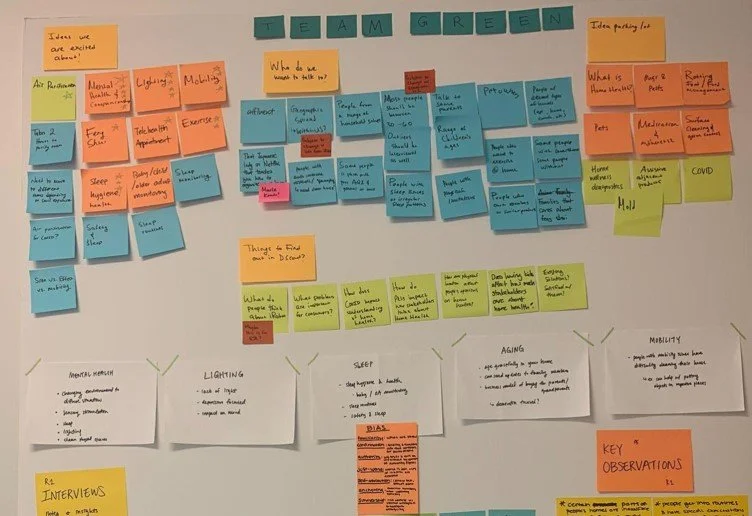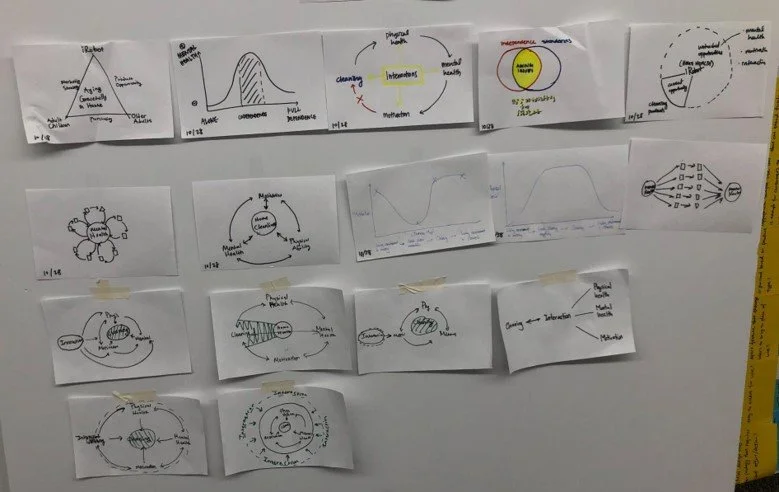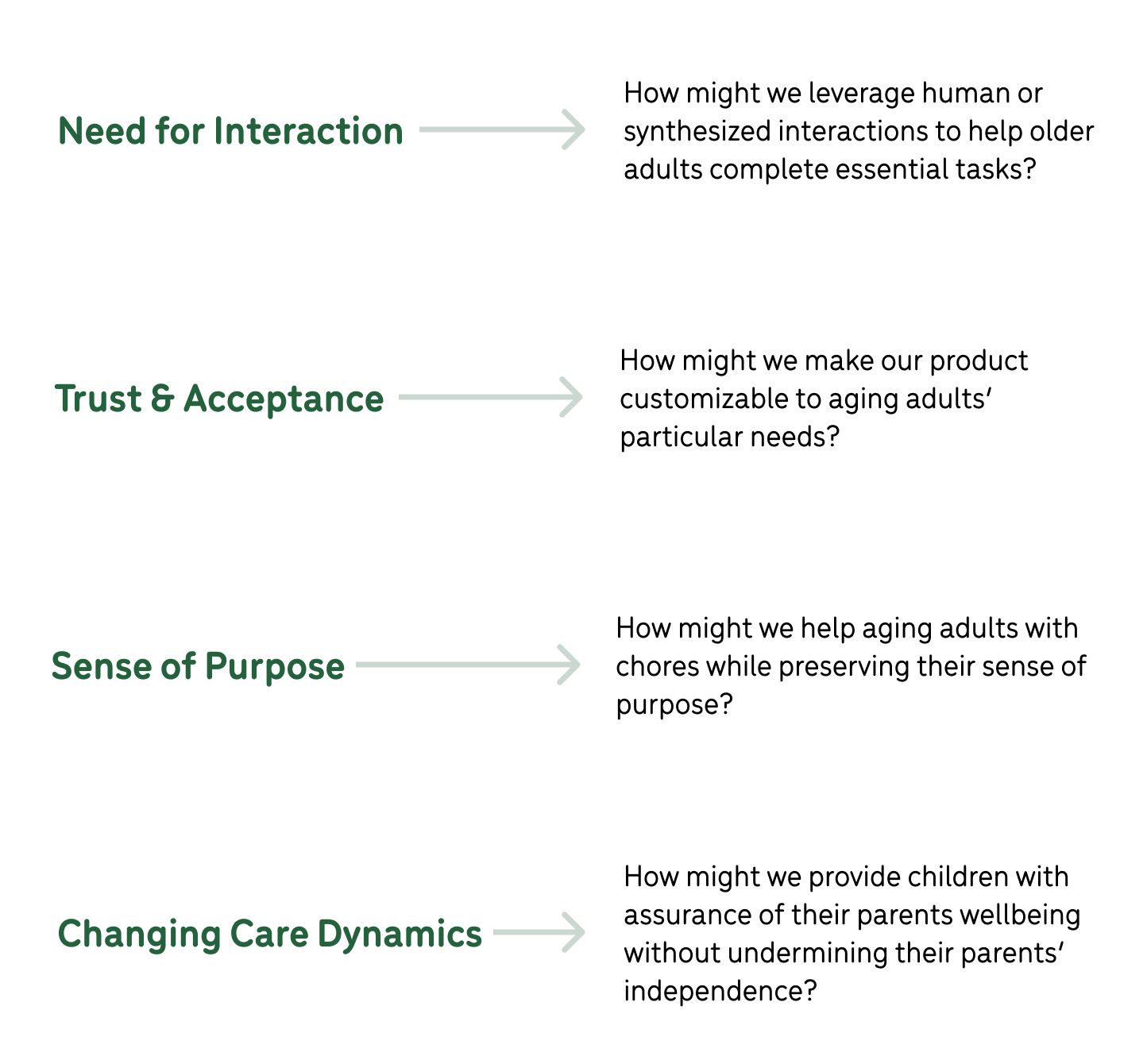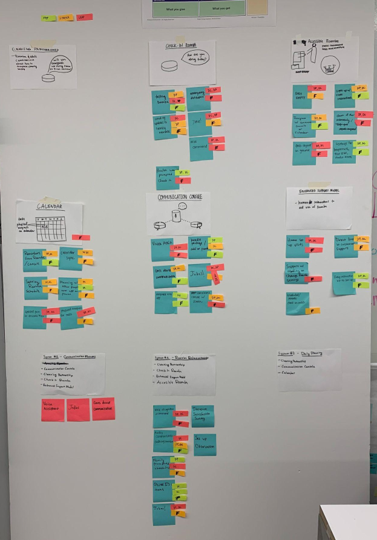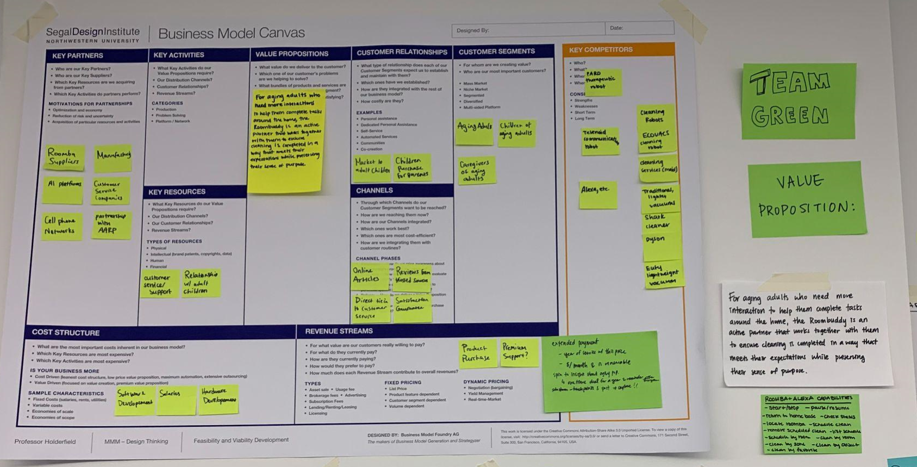Creating a comprehensive concept system to improve aging adults’ interactions with iRobot products.
Design Strategy, Experience Design, Service DesignSeptember 2021 - December 2021
My Responsibilities: Project management, insight development, framework creation, concept system development, UX screen creation.
Deliverables: Concept system, UX screens, slide deck presented to iRobot.
Overview
As part of a design strategy studio class, a group of four of my peers and myself consulted for iRobot as they began exploring the space of home health. To narrow down this prompt, chose to focus on aging gracefully within the home. Through user research and careful development of a business model and product positioning, we created a concept system which we presented to iRobot. We called this system iRobot Connect.
For aging adults who need more interaction to help them complete tasks around the home, iRobot Connect is an active partner that works together with them to ensure cleaning is completed in a way that meets their expectations while preserving their sense of purpose.
Opportunity
At the onset of this project iRobot presented us with two goals:
iRobot wanted to be a thoughtful partner in consumers’ homes.
iRobot wanted to support the emerging needs in home health.
Our group was assigned the second goal, focusing on home health. The overarching goal of being a thoughtful partner in the home continued to inform the work we did.
Process
Problem Space ExplorationWhen prompted with the focus area of “home health” we began brainstorming different interpretations of what “home health” could mean, to identify a more pointed focus area to design within.
We knew that the space we wanted to focus on should be one in which iRobot already had the “right to win.” Any solution we were to design should build on iRobot’s reputation in the cleaning space and existing relationships with consumers. After careful consideration of iRobot’s existing portfolio of products, and learning of iRobot’s poor market penetration for aging adults, we chose to focus on aging.
Our goal became: Helping older adults age gracefully in their homes.
Primary ResearchAfter identifying our focused problem space of aging gracefully, we began conducting user research. We spoke with aging adults as well as the adult children of aging adults, to get a better sense of their changing needs as they age. We wanted to understand their capabilities with smart technology, barriers to use smart technology, their motivation to clean their home, what prevents them from cleaning their home, as well as how the relationship between aging adults and their adult children changes as they age.
We synthesized this research and identified four key insights:
Through further research we identified interaction as the most impactful area of focus for our solution.
After identifying the importance of interaction on older adults ability to clean, we set out to identify what cleaning products rely on interaction. We plotted different products on a spectrum of Passive and Interactive, and learned that the most interactive products cleaning products on the market were iRobot devices. Through our user research we learned that the smart technology that older adults were most easily able to interact with were ones which relied on voice control. Current iRobot products do not have any voice control capabilities, meaning there was an opportunity to make them much more interactive to finetune the experience to the needs of aging adults.
Framework CreationAfter identifying these foundational insights and focuses for our project, we began brainstorming different frameworks to use to communicate these learnings to our clients. Each member of our group solo-stormed a couple different frameworks, presented frameworks to the group, and then we worked collectively to refine the most promising ones.
Ultimately, we created two distinct frameworks: one which communicates the importance of interaction and one which communicates the way iRobot can capitalize on the changing care dynamic between aging adults and their adult children.
The first shows the relationship between interaction and physical health, mental health and motivation, all factors which impact aging adults ability to clean their home. Currently iRobot only focuses on the actual acts of cleaning, but we saw an opportunity for iRobot to consider all of these factors to create a more impactful product.
The next framework depicts the relationship between aging adults, their adult children, and iRobot. We identified an opportunity to market our solution to the adult children of aging adults in hopes of having them purchase our solution for their parents. This allows iRobot to leverage the existing relationships and trust built with adult children to gain the trust of aging adults. It also positions our product as a intergenerational partner within the home.
IdeationAfter fully understanding the needs of aging adults, their adult children, and iRobot, we began ideating different features for our solution.
To begin this ideation, we took each of our four key insights and framed them as “how might we” questions.
Each member of our group then solo-stormed different solutions to these “how might we” questions, which we then posted up on our big board to sort through, discuss as a team, and come up with more ideas
After sorting, we grouped each feature brainstormed into groups of concepts. We then went through each feature and qualified it as a “step,” “stretch,” or “leap” for feasibility as well as desirability (we looked at desirability through the lens of both aging adults and their adult children).
Creating Concept SystemAfter assessing the feasibility and desirability of features, we began assembling them into a concept system. We knew that our system must have a strategic blend of “steps,” “stretches,” and “leaps” to ensure it is disruptive enough to warrant investment from iRobot but not too forward thinking that the investment required would preclude iRobot from pursuing it.
After creating our concept system, we created a business canvas model to understand exactly how our system will work on a financial level for iRobot.
After playing around with a few names, we named our solution iRobot Connect. iRobot Connect is a collection of features which can be added into any iRobot product, like a Roomba or Braava. iRobot can sell these robots enabled with iRobot Connect at a higher price point than the entry level version of the same products.
Preview of iRobot website selling Roomba s9+ enabled with iRobot Connect
iRobot Connect is broken up into 2 distinct groups of features separated by 2 different pay structures:
iRobot Connect - Baseline Features
Voice command in Robots
Robot seeks feedback
Tie-in to family members’ iRobot app
Family outside the home can check in on their loved ones with Robots
iRobot Assist - Premium Subscription Service
In-home set up with an iRobot Assistant
Reliable customer support accessible 24/7
Direct calling to iRobot Assist through Bluetooth connection to Robots
iRobot Assist has remote access to Robot and its settings
The key features which make up iRobot Connect and iRobot Assist can be seen below:
1. Voice Command
Summary:
Voice command should be incorporated directly into iRobot devices so aging adults can interact verbally with robots. This makes iRobot devices more accessible to aging adults with a range of different limitations (eyesight issues, issues physically manipulating phones, hearing issues through potential connection with Bluetooth enabled hearing aids) as well as for older adults who struggle learning how to use new applications. This gives older adults a new form of verbal interaction throughout their day, with potential to make iRobot products more conversational and less utility based if that is desired by the users (customizations can be set during in-home setup).
2. In-home Setup
Summary:
The children of aging adults have the ability to schedule in-home setups for their parents through iRobot Assist. During the in-home setup, iRobot Assist will:
Teach aging adults how to use their new product
Input aging adults’ desired cleaning settings for each room
Input aging adults’ privacy settings associated with their children’s application
Show them the Bluetooth calling capability so they can get help whenever they want
This reduces confusion for aging adults as they begin to use a new technology, and builds trust between them and their iRobot product. It exposes them to the capabilities of iRobot Connect & Assist.
3. Bluetooth Calling to iRobot Assist
Summary:
When aging adults have issues with the voice command feature in their iRobot devices as they try to change settings, iRobot Connect will sense when there are communication lapses and offer to call iRobot Assist directly. When calling iRobot Assist, the aging adult will be able to speak to a real human and explain the changes they would like to make. iRobot Assist is then able to go in and remotely change the settings of the aging adults iRobot device. This eliminates confusion for aging adults and ensures product satisfaction. It also incorporates interaction to keep older adults positive and avoid frustration.
4. Wellness Checks
Summary:
Children of aging adults can initiate wellness checks on their parents if they are worried about them. They can send their parents a message, and have the iRobot device go looking around their parent’s to find their parent and make sure they are healthy. This relieves stress of adult children by keeping them in the loop and promotes independence of aging adults while ensuring their safety.
5. Cleaning Suggestions
Summary:
As the iRobot device cleans the home, it will ask the aging adult to straighten up different rooms so it can clean to the best of its ability. This preserves aging adults sense of purpose by keeping them busy within their home, and promotes their trust of the robots by helping them understand why cleaning is not always completed as specified.
6. Satisfaction Survey
Summary:
After completing essential cleaning tasks, the iRobot product will check in with the aging adult to ensure that the tasks were completed to their satisfaction. It will ask if it could do anything better, and change the settings for future reference. This ensures cleaning meets aging adults’ specific cleaning expectations and helps establish cleaning partnership between older adults and robots.
Presenting to ClientsAs we prepared our presentation to our clients at iRobot, we knew we need to present our system in a creative way to ensure they would understand all the touchpoints we had designed. To do so, we storyboarded the story of Irene, an aging adult and Aiden, her adult son.
After that, a member of my team illustrated each step of the interaction, while I created the UX touchpoints that were necessary to include.
Impact
After presenting our work to our clients at iRobot, we received incredibly positive feedback, both from our client and from our professor.
This project was significant for my professional growth, having given me the chance to act on my project manger skills and grow them in a consulting and strategy setting. This project was also particularly exciting as it was the first time I was able to design work in person since the start of my master’s program – we got messy with sticky notes and project boards, and were able to be as visual as we wanted with our frameworks.











